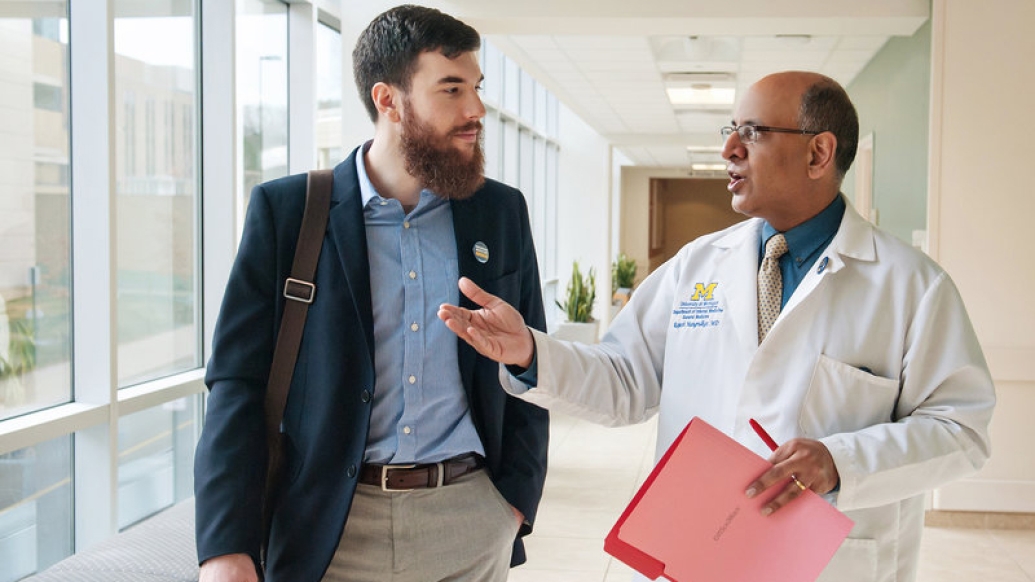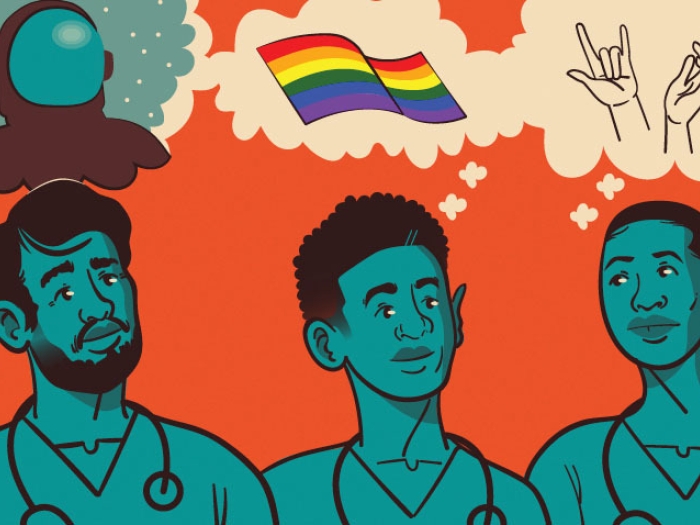Increasingly, medical schools are offering students the chance to choose a scholarly concentration, such as health policy or global medicine.
7:00 AM
Author |

For more than a century, going to medical school has meant basically the same thing: four years of learning about human anatomy and physiology, and about how to diagnose and treat disease.
MORE FROM MICHIGAN: Subscribe to our weekly newsletter
But in the past few years, more med schools have added optional "scholarly concentration" tracks that students can pursue even while earning a medical degree. You might think of it as a "minor" — an add-on to the "major" of medicine — a chance to focus on a topic long before students pick a particular type of care to study in residency.
A growing trend
Now, a University of Michigan Medical School team has published the first national study of this idea. It shows that 74 percent of the top U.S. medical schools offer scholarly concentrations to their students.
Most schools offer five or six choices, the team reports in the journal Academic Medicine. The topics vary widely, with 199 distinct options available across the 43 schools that rated in the top tiers of U.S. News & World Report's two medical school ranking charts.
But a close examination showed that the "minors" across these schools boiled down into 10 buckets, or domains of related topics.
Most popular was global health, offered by nearly all of the schools that allowed students to choose a concentration. Next were research-related specializations, followed by ethics and humanities, health policy and medical education.
"All of these schools, including Michigan, offer scholarly concentrations to give students a grounding in critical thinking, problem-solving and methodology in a particular area of focus. This has been missing in the traditional curriculum," says Jesse Burk-Rafel, the U-M fourth-year medical student who led the study.
"Certainly, all medical students learn clinical problem-solving, but a concentration allows a school to formalize a more scholarly community that surrounds students with faculty and other students with the same intellectual curiosity about that subject matter."
These programs help foster students' passions … [and] will pay real dividends down the line to improve patient and community health.Jesse Burk-Rafel
A path to more paths
Burk-Rafel and his co-authors didn't do the study just to take the temperature of medical education. They were on a mission to help their own school.
Michigan launched its first scholarly concentration, called a Path of Excellence in Global Health & Disparities, in 2011. It built on the school's burgeoning strength in global health and attracted students interested in reducing health disparities overseas and in the U.S.
A second path, in ethics, was added in 2013, and one on health policy was added in 2014.
By that year, when Burk-Rafel was a second-year student, Michigan's medical education leaders knew they wanted to grow the Paths of Excellence further to meet student demand.
The question was how to do it — and not overdo it.
For the answer, Burk-Rafel and his colleagues turned to the school's current students. Even though most were too far along in their training to choose a path for themselves, more than 450 students — nearly two-thirds of the student body — took part in a survey to understand which topics most interested the scholars.
The survey used an approach called exploratory factor analysis (EFA), allowing students to rank their preferences, or enter the same rank for choices they liked equally well. The survey listed choices similar to those documented in the national study, but with additional options that link to the strengths of Michigan's faculty.
This let researchers see which paths would give the most students the chance to get into their first or second choice of topic while still allowing the school to expand its Paths of Excellence program in a manageable way.
"It's fitting that student-led research helped the institution figure out what students want, and balance that with institutional constraints to create a number of offerings," says Burk-Rafel. "Our approach was locally helpful but also nationally, it's an innovative approach to create a number of offerings in any curriculum setting."
Expanding the paths was part of a much larger reimagining of the curriculum, which Burk-Rafel and other students were helping plan.
Survey says …
The survey results factored directly into how Michigan grew its Paths of Excellence program to eight choices. Each has its own faculty advisers, special experiences and capstone project requirements.
The incoming class that started in August could pick from Ethics, Global Health & Disparities, Health Policy, Innovation & Entrepreneurship, Medical Humanities, Patient Safety/Quality Improvement/Complex Systems, Scholarship of Learning & Teaching and Scientific Discovery.
Now, 240 students are enrolled in a Path of Excellence.
"The additional paths really allowed us to hit the sweet spot," says Burk-Rafel. "Below six, we wouldn't be offering students the choices that would satisfy them, but with eight paths total, students can overwhelmingly find an area of interest and get placed into their first choice."
SEE ALSO: Med School Mental Health: 1 in 4 Students May Be Depressed
Heather Wagenschutz, M.A., M.B.A., who co-directs the Paths of Excellence program and leadership training for U-M medical students, notes that many people took part in planning the new paths.
"We gathered as many perspectives and ideas as we could, but reached a decision-making point: How many paths did we have the resources for, and which paths would be the right combination?" she says. "The thoughtful institutional needs assessment and the EFA on preferences gave us the data-driven approach we craved. This assured the work group on how to proceed in the best direction and helped to inform final content development."
Ironically, Burk-Rafel's own interest — medical education — was chosen as the basis for the Scholarship of Learning & Teaching Path, but it rolled out too late in his medical school career for him to choose it.
Still, he knows that the new paper, his involvement in the curriculum redesign and his selection as a presenter at the Association of American Medical Colleges' national Research in Medical Education conference show his devotion to the subject. As he interviews at residency programs, he sees his self-directed concentration in medical education as an asset.
Burk-Rafel hopes the same will be true for future students who choose a concentration. Even if they don't go on to work in the field they chose in medical school, engaging in a scholarly effort can set them apart during residency and beyond.
"Concentrations allow students to distinguish themselves, by showing what they're passionate about through a deliverable — a presentation, website, paper or other project that they completed through their concentration," says Burk-Rafel. "They can show that to people to say, 'This may not be what I continue to do long term, but the process of doing this and skills I've learned are valuable to addressing problems and leading change.'"
In the end, he says, "these programs help foster students' passions, capitalizing on their interests but adding value through mentorship and structure. That will pay real dividends down the line to improve patient and community health."

Explore a variety of healthcare news & stories by visiting the Health Lab home page for more articles.

Department of Communication at Michigan Medicine
Want top health & research news weekly? Sign up for Health Lab’s newsletters today!





